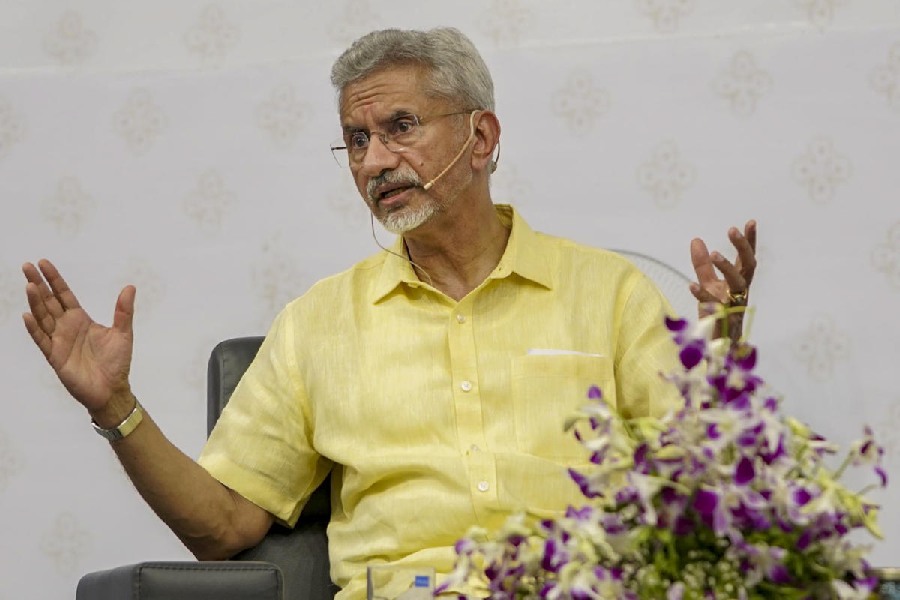 |
Norwegian salmon with masala mashed potatoes, pasta with aubergine stew, Thai marinations cooked in the tandoor, Indian naan with Moroccan spices? A mix and match ? literally ? of world cuisine is the mouth-watering menu at Atrium, summed up in a sentence.
Try pleasing the mostly traditional palate of a Calcuttan 24x7, and it?s guaranteed to be a test of taste and time. So says Shaun Kenworthy, executive chef, The Park (picture above). ?If you ask 50 different people to cook yellow dal, each one will be different.?
The Britisher does what he can to keep the customers happy at the round-the-clock coffee shop of the Park Street hotel. Of course, it does help that the food comes in gigantic proportions at ?high street prices?. The USP of this restaurant is the changing menu, with constant innovations and improvisations to come up with not just fusion food, but ?modern Indian and international cuisine?.
Experimentation might not always work, and certainly not with everyone. But it?s the motto of ?something for everyone? that Shaun feeds of. So, while the rabbit was short-lived, he bounced back with naan cooked with curry leaves and coconut to go with a south Indian dish, salmon in tomato gravy and pasta with a sauce containing cumin, coriander, mint and garlic.
?Indian cuisine hasn?t really changed in the past 200 years. There are lots of different spices and ingredients available now, which can be used in many ways. For instance, sambar has a lot of vegetables in it, but no one really likes it with zucchini and babycorn. I love playing around, though, particularly with kebabs. In a coffee shop, you have more room to do so. In fact, I use the tandoor for a lot of different things, from Thai lobster to Portuguese chicken,? says he.
 |
The ingredients pour in from around the world all through the day, starting at 6.30 am and going right up till 8 pm. First up are the breakfast breads and confectioneries (now it?s all from Flurys), followed by meats, spices and other items from various places, and ending with English vegetables like red capsicum and zucchini from Bangalore.
There?s a little bit of almost every country?s culinary culture in Atrium?s small but busy kitchen. Smoked duck from France, New Zealand lamb from the sheep country, Italian cheese (ordered two weeks in advance) and Norwegian salmon from Scandinavia are a few of the delicious delights. There?s a dish or two of Spanish and Mexican origins, a Portuguese offering and much more.
Indian, Thai and Chinese cannot be ignored by any restaurant in Calcutta, but even these are cooked with a quirky twist to infuse them with unique flavours. Like paratha with zatar, a Moroccan spice, pasta sauces that have a tinge of curry taste and Thai dishes with a whiff of tandoor.
The Tenderloin Steak and Pork Chops are high on the list of top five items at Atrium ? ?partly because they are not really available in most other places? ? as are Fish ?? Chips and sandwiches. But there?s an interesting story behind even this mundane menu: ?The pork?s local. There?s a lady a little outside Calcutta who breeds Suffolk pigs. I buy from her.?
And then there are the food festivals. Last year, they encompassed a whole range of world cuisine, with the spicy aromas of Mauritian munchies, the tangy taste of North Indian chaats and a retro tribute to Park Street food fare with the Prawn Cocktail festival to name a few. But there?s more in store, with plans for a Moroccan/Leba-nese festival soon.
This is a kitchen that never sleeps, much like the people who come here to eat, drink and be merry. So it?s in a constant state of mise en place (the process of preparation). The bulk preparation, like cooking pasta sauces, marinating and putting together the ingredients, is done in the lean times ? between breakfast-lunch and dinner-breakfast. The pantry prepares bread and fresh juices through the day, while the starter section does the snacks and appetisers.
 |
The kitchen is also a study in cultural crossovers, with a Thai chef, an Indian chef, an Italian-trained chef and other temporary taste-masters stirring up storms for the food festivals. Each one picks up tips from the other, fusing together elements to excite the senses as much as keep hungry tummies happy.
?Indians are the hardest to cook for. They are stubbornly set against change. And the customer here is very much the king. If he wants it done some way, we do it. Only about five per cent experiments. But if you?re bothering to go out, then you might as well eat something new,? signs off Shaun.










